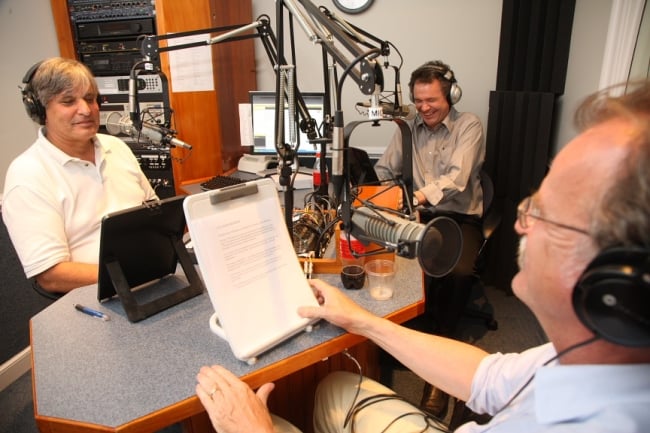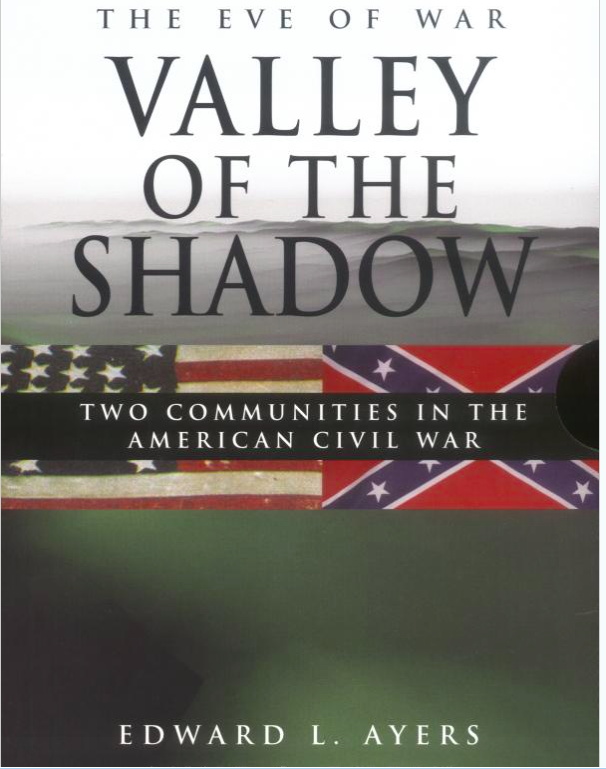You have /5 articles left.
Sign up for a free account or log in.

Ed Ayers (center) and partners doing their BackStory radio show.
Virginia Foundation for the Humanities
Ed Ayers stepped down as president of University of Richmond in June 2015 after an eight-year run. Plenty of distinguished university leaders like him would use their postpresidency time to relax -- or to take up a hobby, perhaps.
But Ayers had other plans.
“The whole time, I knew I wasn’t finished being a historian,” Ayers said in an interview with “Inside Digital Learning.”
“What I wanted to do was connect with as broad an audience as possible.”
Those efforts are underway, and they’ve already taken several forms. Ayers polished the second and final volume of his book Valley of the Shadow, assembled from his landmark digital humanities project of the same name from the early 2000s, for release Oct. 24. He also continues co-hosting the BackStory podcast, in which he’s been taking deep dives into historical issues since 2008.
In several other arenas, he’s in a leadership role that he and others describe as “executive producer,” overseeing projects at the Digital Scholarship Lab, a digital humanities lab at Richmond that contributes research and teaching. And most intriguing, he’s half of the duo behind Bunk, a project launching this week that represents the peak of Ayers’s ambitions thus far. The website describes itself as “a shared home for the web’s most interesting writing and thinking about the American past.”
His goals are lofty.
“When I was a dean, I noticed that the sciences seem to have ways of connecting with broader audiences. Ironically, we’re not very good at presenting history as an exciting field,” Ayers said. “That’s the utility of all this. I’m trying to make history cool.”
Where It All Started
The internet as it exists today wasn’t an option for Ayers when he started building Valley of the Shadow, which he describes as an online repository for “every piece of information about every person who lived in every Northern community and Southern community” during the Civil War.
It’s held up better than even he anticipated, though the goal was to make a resource to stand the test of time.
“It’s clear that it’s not of the latest generation,” Ayers said. But, he added, “I wanted to show that we can make something and it’ll work every day for 25 years. And reach more people in a week than our books will in a year.”
 The first Valley of the Shadow book, adapted from the resource’s contents, came out in 2003, covering events from 1859 to 1863. Shortly thereafter, Ayers became a dean at the University of Virginia, and he decided to put the companion edition on hold so he could write, as he puts it, 1,000 pages in 10 years as opposed to 500 pages right then.
The first Valley of the Shadow book, adapted from the resource’s contents, came out in 2003, covering events from 1859 to 1863. Shortly thereafter, Ayers became a dean at the University of Virginia, and he decided to put the companion edition on hold so he could write, as he puts it, 1,000 pages in 10 years as opposed to 500 pages right then.
The goal of spinning his digital project into a physical product was not, as some observers might suspect, to kowtow to the inevitable demands for physical media from the scholarship market. Rather, he says, a traditional source derived from a publicly available online archive disproves the notion that digital tools are “cold” and “mechanical.”
Pivot to Grander Gestures
Now Ayers has set his sights beyond the Civil War, in hopes of inspiring new generations of learners. During his first-year seminar course Touching the Past this spring at Richmond, where he is the Tucker-Boatwright Professor of the Humanities, Ayers guided students to create Reconstructing Virginia, a digital humanities project detailing the transformation of the university’s home state from Confederate capital to thriving postsecession society.
At Richmond’s Digital Scholarship Laboratory, Ayers has been helping create a “digital atlas of American history.” Maps from the project recently appeared in The New York Times and were honored by National Geographic last year.
And then there’s Bunk. The tongue-in-cheek moniker comes from a Henry Ford quote: “History is more or less bunk.” It’s safe to say Ayers doesn’t believe that. In fact, he hopes to make history easier to access than ever before with this new device, which will eventually generate a constantly updating archive of news media reports and academic scholarship related to current events.
The site is just getting off the ground with a soft launch this week; a more formal kickoff will take place later this year, according to the site’s editor, Tony Fields, a public radio professional who met Ayers on the BackStory podcast.
Whenever Fields talks to Ayers, he said he feels a renewed confidence that digital humanities will take even firmer hold soon.
“He has a strange and at times frightening -- but ultimately gratifying -- sense of optimism about the possibilities of this moment in digital media production,” Fields said.
Fields isn’t the only colleague of Ayers’s who’s awed and confounded at times by the digital humanities proponent’s unique passion. Rob Nelson, director of the Digital Scholarship Lab, describes Ayers as a global thinker with an enormous vision.
“I don’t think I would have come up with this,” Nelson said of the atlas project, which is still under way. “I would have had the good sense not to try and do something this ambitious.”
The Road Ahead
In some ways, Ayers’s scholarship around the Civil War has never been more relevant. Debates are raging nationwide over the future of Confederate statues, and plans to remove them have sparked violent protests from white supremacists and other hate groups. Race relations are at a boiling point. At their root, unspoken or otherwise, is the institution of slavery and the American divisions over it that haven’t receded.
As a member of a commission in Richmond that’s contemplating the future of the city’s many Confederate statues, Ayers has been watching this debate carefully. He hopes efforts like his will move public discourse in a more nuanced direction, away from binary debates and context-free arguments.
“I chose what I studied for a reason. Slavery, war. They are the great problems at the heart of American history,” said Ayers, who has been teaching since 1980. “They’re going to keep reasserting themselves in one way or another.”
Ayers believes he’s earned the cachet to help up-and-coming academics innovate. His own curious mind won’t let him do anything less.
“My goal has been to use my seniority to help move some of this along,” Ayers said. “The junior people can’t really afford to do this. If you’re already the dean or the president, you can go ahead and create these things.”
And, he says, if it all works out, other people will carry on his work long after he’s gone.
“I hope they surprise me,” Ayers said. “I hope they think of things better than I’ve been able to think of.”




